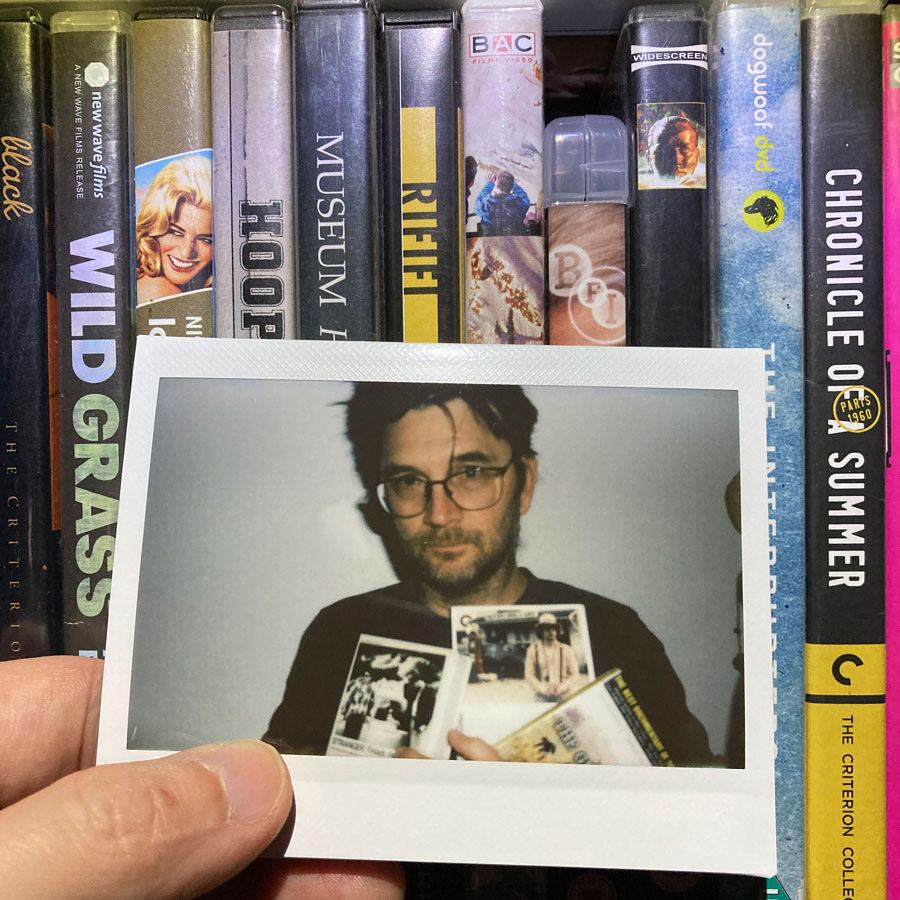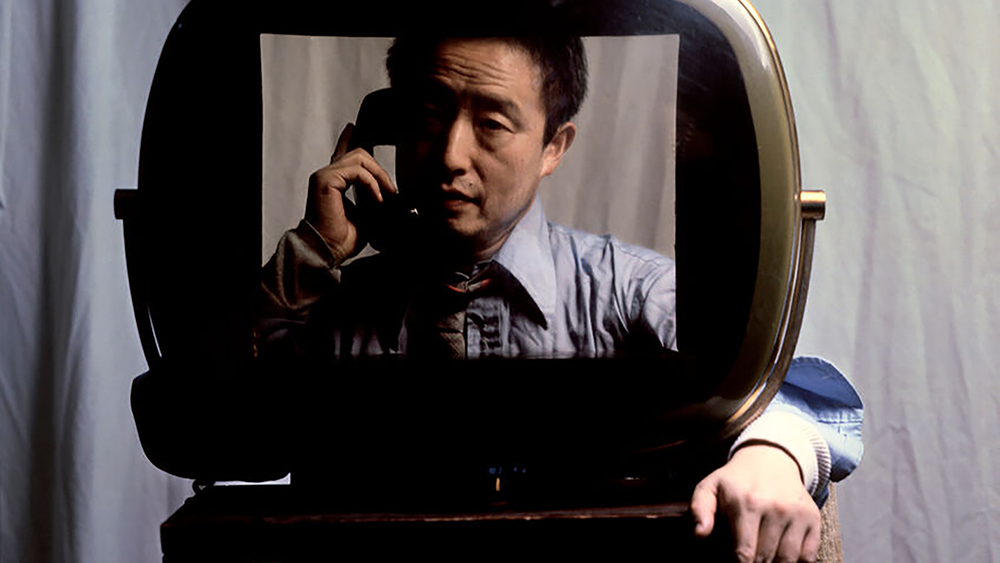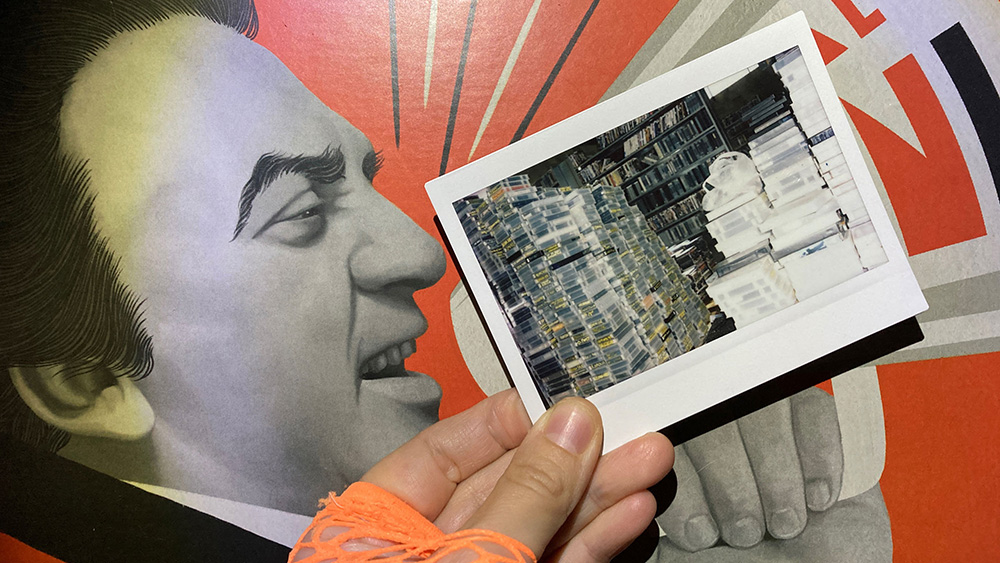
March 25, 2023
Sundance/Slamdance 2023: Media Arts
This year at the 2023 Sundance and Slamdance Film Festivals one can sense anxiety as well as nostalgia, a fractured world searching for sense and meaning. Here is a roundup of films that feature the media arts.

Still from Nam Jun Paik
Films about the media arts kicked off with Nam Jun Paik (1932 – 2006), the Korean-American video artist who started as a music student in Japan, then Munich, Germany shifting his influence from Arnold Schoenberg (1874 – 1951) to John Cage (1912 – 1992) to Karlheinz Stockhausen (1928 – 2007) and fell into Fluxus and conceptual art (George Maciunas, Joseph Beuys). Note: Fluxus had other Asian artists like Yoko Ono as members. Paik became a “performance musician” keen to destroy Western culture symbols like the piano and violin. He witnessed firsthand the dividing of East and West Germany, which mirrored what had happened in Korea 16 years before splitting his homeland into North and South Korea. Paik noted that Hitler had radios made without a dial, hence only one channel. Television was the new medium and he purchased the new Sony Port-a-Pak, the first commercially available video recorder; and his first exhibit with TV took place in 1963 (Exposition of Music-Electronic Television, at the Galerie Parnass in Wuppertal, West Germany). In 1964, Paik immigrated to New York where he began working with classical cellist Charlotte Moorman combining video, music, and performance. Paik’s “Electronic television” formed a transmitter into one’s life.

Still from Kim’s Video
In the days of DVD and VHS video rentals, Kim’s Video was a film lover’s dream with 55,000 hard-to-find eclectic works available to its more than 250,000 members. With a flagship store on Avenue A in New York’s East Village beginning in 1987 growing to four additional satellite locations, founder Yongman Kim, a South Korean immigrant, was forced to close as viewers migrated to Netflix, streaming services and other means to view obscure and mainstream films. Like Quentin Tarantino’s tenure as a video store clerk in California, many future film people worked at Kim’s including directors Robert Greene (Procession), and Alex Ross Perry (Listen Up Philip), and cinematographer Sean Price Williams (Good Time). In 2008, forced to close his stores, Kim sought takers for the movie collection who would meet three criteria: 1) keep the collection intact, 2) continue to update it, and 3) make it accessible to Kim’s members. The ancient town Salemi in Northeast Sicily, Italy, hoping to revitalize the town which still had not recovered from the devastating 1968 earthquake made a successful bid for the collection as part of a village restoration effort. Although the collection was transferred to Salemi, nothing happened. Filmmaker David Redmon, who was a member of Kim’s, went to Salemi to find out what happened and discovers the stash disintegrating in a warehouse in the back of a ruin. Those who proposed Salemi as Kim’s new home had good intentions, the project was taken over by the likes of Vittorio Sgarbi, the former mayor and TV art critic, and Pino Giammarinaro, an associate of Silvio Berlusconi with Mafia ties. The documentary turns into a heist film with Redmon determined to save Kim’s Video. He is not permitted to film inside the ruin for his documentary, but is granted permission to use it as a location for a fiction feature film he claims to be shooting. Once inside, he steals the VHS and DVDs, loading them into a truck, and brings back to New York, where it is now called Kim’s Video Underground at Alamo Drafthouse Cinema in lower Manhattan where it offers offers 5-day rentals for free.
Fantastic Machine is about the camera capturing both still and moving images, from the initial photo made in the 1820s to today’s mobile phone picture-taking mania.The title refers to French filmmaker Georges Melies’ fictional The Coronation Of Edward VII (1902) staged in a studio in France and premiered the day of the actual event, which was greeted by the King himself with the exclamation “what a fantastic machine.” With 45 billion cameras in the world and 500 hours of ’content’ created every minute, the filmmaker wrestles with science, politics, and ethics as well as aesthetics. A section focuses on the Nazi era with an interview with filmmaker Leni Riefenstahl describing her techniques in The Triumph Of The Will (1934) as well as British media executive Baron Sidney Bernstein describing being one of the first to film the Nazi concentration camps after liberation which he thought would silence Holocaust deniers. The clips and images in Fantastic Machine form an incredible, visual tale ranging from the authentic to fake news. Former president of Ireland Éamon de Valera says: “Like atomic energy, [it] can be used for incalculable good, but it can also do irreparable harm.”
Deep Sophia is an interactive video installation at the intersection of artificial intelligence, ‘deep fakes,’ and motion capture. Utilizing facial recognition software, the Sophia Robot (a social humanoid robot developed by the Hong Kong-based company Hanson Robotics activated in 2016 and modeled after Egyptian Queen Nefertiti, Audrey Hepburn, and its inventor’s wife, Amanda Hanson) is mapped onto the faces of women from historical films: Brigitte Helm in Metropolis (1927, Fritz Lang), Renée Jeanne Falconetti in The Passion of Joan of Arc (1928, Carl Dreyer), Janet Lee in Psycho (1960, Alfred Hitchcock), Gloria Swanson in Sunset Boulevard (1950, Billy Wilder), Sharon Stone in Basic Instinct (1992, Paul Verhoeven), Linda Blair in The Exorcist (1973, William Friedkin), and the twins in The Shining (1980, Stanley Kubrick). Similarly, the viewer’s face is grafted into the film installation. It’s a different form close-up.
All Sundance and Slamdance 2023 Category Reviews
The Built Environment
Visual Arts
Media Arts
Art + Life
Performing Arts
Literary Arts
Music
Films Mentioned
Nam Jun Paik. Director Amanda Kim. Sundance
Kim’s Video. Directors David Redmon and Ashley Sabin. Sundance
Fantastic Machine. Directors Axel Danielson and Maximilien Van Aertryck. Sundance
Deep Sophia. Director Yvette Granata. Slamdance
Observed
View all
Observed
By Susan Morris
Related Posts

Graphic Design
Sarah Gephart|Essays
A new alphabet for a shared lived experience

Arts + Culture
Nila Rezaei|Essays
“Dear mother, I made us a seat”: a Mother’s Day tribute to the women of Iran

The Observatory
Ellen McGirt|Books
Parable of the Redesigner

Arts + Culture
Jessica Helfand|Essays
Véronique Vienne : A Remembrance
Recent Posts
Compassionate Design, Career Advice and Leaving 18F with Designer Ethan Marcotte Mine the $3.1T gap: Workplace gender equity is a growth imperative in an era of uncertainty A new alphabet for a shared lived experience Love Letter to a Garden and 20 years of Design Matters with Debbie MillmanRelated Posts

Graphic Design
Sarah Gephart|Essays
A new alphabet for a shared lived experience

Arts + Culture
Nila Rezaei|Essays
“Dear mother, I made us a seat”: a Mother’s Day tribute to the women of Iran

The Observatory
Ellen McGirt|Books
Parable of the Redesigner

Arts + Culture
Jessica Helfand|Essays

 Susan Morris works across media — film, television, radio, exhibitions, public programs, print, digital media — specializing in the arts and culture with an emphasis on architecture & design as a producer, director, editor, curator and writer. She has worked at Publications: Louise Blouin Media (Editor-in-Chief, Modern Painters), Architect’s Newspaper, Art Newspaper, Artbyte, Documentary, Dwell, Eye, House & Garden, and Design Observer; Foundations: Ford Foundation, NEA, Rockefeller Foundation; Media Production: WNYC/PRI (founding Executive Producer Studio 360), BBC UK, Bravo, IFC, NY Times Television, WNET/Thirteen; Museums & Institutions: Cooper-Hewitt National Design Museum, J. Paul Getty Trust, International House, Metropolitan Museum of Art, MoMA.
Susan Morris works across media — film, television, radio, exhibitions, public programs, print, digital media — specializing in the arts and culture with an emphasis on architecture & design as a producer, director, editor, curator and writer. She has worked at Publications: Louise Blouin Media (Editor-in-Chief, Modern Painters), Architect’s Newspaper, Art Newspaper, Artbyte, Documentary, Dwell, Eye, House & Garden, and Design Observer; Foundations: Ford Foundation, NEA, Rockefeller Foundation; Media Production: WNYC/PRI (founding Executive Producer Studio 360), BBC UK, Bravo, IFC, NY Times Television, WNET/Thirteen; Museums & Institutions: Cooper-Hewitt National Design Museum, J. Paul Getty Trust, International House, Metropolitan Museum of Art, MoMA.